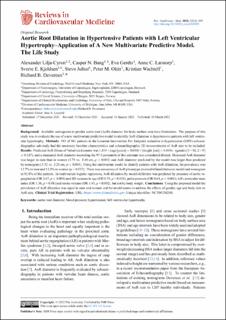| dc.contributor.author | Lilja-Cyron, Alexander | |
| dc.contributor.author | Bang, Casper N. | |
| dc.contributor.author | Gerdts, Eva | |
| dc.contributor.author | Larstorp, Anne Cecilie Kjeldsen | |
| dc.contributor.author | Kjeldsen, Sverre | |
| dc.contributor.author | Julius, Stevo | |
| dc.contributor.author | Okin, Peter M. | |
| dc.contributor.author | Wachtell, Kristian | |
| dc.contributor.author | Devereux, Richard B. | |
| dc.date.accessioned | 2023-03-09T13:02:47Z | |
| dc.date.available | 2023-03-09T13:02:47Z | |
| dc.date.created | 2022-05-18T16:25:28Z | |
| dc.date.issued | 2022 | |
| dc.identifier.issn | 1530-6550 | |
| dc.identifier.uri | https://hdl.handle.net/11250/3057390 | |
| dc.description.abstract | Background: Available nomograms to predict aortic root (AoR) diameter for body surface area have limitations. The purpose of this study was to evaluate the use of a new multivariate predictive model to identify AoR dilatation in hypertensive patients with left ventricular hypertrophy.
Methods: 943 of 961 patients in the Losartan Intervention For Endpoint reduction in hypertension (LIFE) echocardiographic sub-study had the necessary baseline characteristics and echocardiographic 2D measurements of AoR size to be included.
Results: Predicted AoR (Sinus of Valsalva) diameter was 1.519 + (age [years] × 0.010) + (height [cm] × 0.010) – (gender [1 = M, 2 = F] × 0.247), and a measured AoR diameter exceeding the 97.5-percentile of this estimate was considered dilated. Measured AoR diameter was larger in men than in women (3.75 vs. 3.48 cm, p < 0.001) and AoR diameter predicted by the model was larger than predicted by nomogram (3.52 vs. 3.28 cm, p < 0.001). Using the multivariate model to identify patients with AoR dilatation, the prevalence was 13.7% in men and 12.3% in women (p = 0.537). There was consensus of AoR phenotype (normal/dilated) between model and nomogram in 92.8% of the patients. In multivariate logistic regression, AoR dilatation by model definition was predicted by presence of aortic regurgitation (OR 2.67, p < 0.001) and SD increase in age (OR 0.75, p = 0.023), pulse pressure (OR 0.64, p < 0.001), left ventricular mass index (OR 1.36, p = 0.08) and stroke volume (OR 1.45, p = 0.002), but not by body weight.
Conclusions: Using the proposed model the prevalence of AoR dilatation was equal in men and women and the model seems to address the effects of gender, age and body size on AoR size. | en_US |
| dc.language.iso | eng | en_US |
| dc.publisher | IMR Press | en_US |
| dc.rights | Navngivelse 4.0 Internasjonal | * |
| dc.rights.uri | http://creativecommons.org/licenses/by/4.0/deed.no | * |
| dc.title | Aortic root dilatation in hypertensive patients with left ventricular hypertrophy–application of a new multivariate predictive model. The Life Study | en_US |
| dc.type | Journal article | en_US |
| dc.description.version | publishedVersion | en_US |
| dc.rights.holder | Copyright 2022 the authors | en_US |
| dc.source.articlenumber | 095 | en_US |
| cristin.ispublished | true | |
| cristin.fulltext | original | |
| dc.identifier.doi | 10.31083/j.rcm2303095 | |
| dc.identifier.cristin | 2025366 | |
| dc.source.journal | Reviews in Cardiovascular Medicine | en_US |
| dc.identifier.citation | Reviews in Cardiovascular Medicine. 2022, 23 (3), 095. | en_US |
| dc.source.volume | 23 | en_US |
| dc.source.issue | 3 | en_US |

